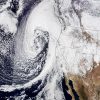The latest report from the United Nations’ weather agency has confirmed the onset of an El Niño event, amidst record-breaking global ocean temperatures and heightened concerns about the impacts on the world’s climate. For Australia, this pronouncement brings with it a heightened risk of drought, heatwaves, bushfires, and coral bleaching, as the nation’s Bureau of Meteorology notes that sea surface temperatures in the central Pacific have already surpassed the El Niño threshold.
However, the bureau’s declaration of an El Niño has yet to be made official, pending further observations of wind, cloud, and atmospheric pressure patterns typically associated with this phenomenon. According to experts, El Niño’s influence on global heating will push average temperatures to all-time record highs either this year or the next.
Global ocean temperatures have consistently hit record highs over the past year, with April being the latest instance of a record-breaking month. This trend is attributed to the absorption of excess heat by the world’s oceans, primarily caused by the accumulation of greenhouse gases from fossil fuel emissions. A recent study led by scientists at CSIRO suggests that human-caused global heating has likely increased the frequency and extremity of El Niño and La Niña events since the 1960s.

The likelihood of El Niño spells out a hotter and drier outlook for Australia, exacerbated by the wet La Niña years that brought major vegetation growth across the nation. With increased fuel for fires, this development has raised concerns about the potential for bushfires to rage uncontrollably. Dr. Wenju Cai, an El Niño expert at CSIRO, notes that after previous “triple La Niñas,” an El Niño event typically follows, but this one is expected to be moderate rather than super intense.
The Bureau of Meteorology has issued a warning, stating that the Pacific Ocean and atmosphere have yet to fully couple during this El Niño event, as is typically observed. Climate scientists caution that the ongoing El Niño event will likely have devastating consequences for Australia, as it amplifies heatwaves, droughts, and bushfires, while also bleaching coral reefs.
The declaration of an El Niño event serves as a stark reminder of the world’s burgeoning climate crisis, with Australia at the forefront of its impacts. As the nation navigates this impending shift towards a hotter and drier climate, it is essential to take stock of the consequences and contemplate a more sustainable future for the planet.

